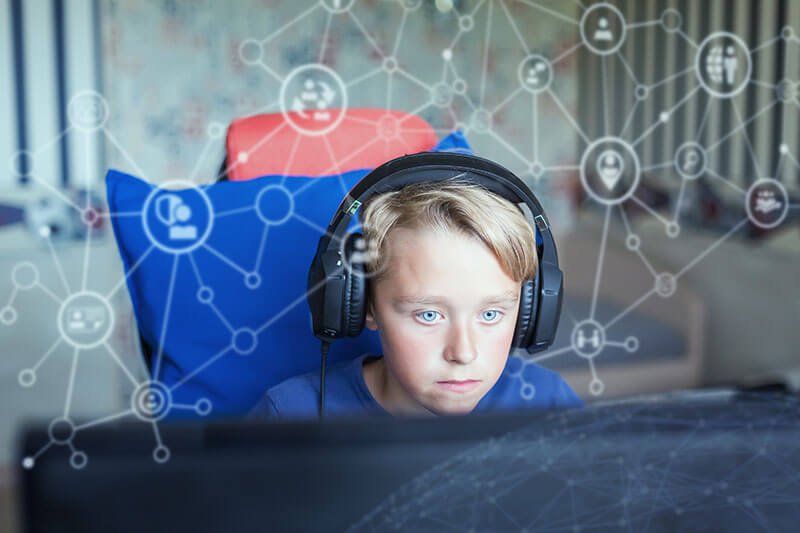By Kim Robinson, PhD
How do you protect your child from online predators? This is a question we at Ranch Hands Rescue are often asked when speaking in the community. Our answer is simple. The greatest weapon in the fight against child sex trafficking is “INFORMATION”. It is the foundation for all of the other tools we use to combat this crime. This is a tough topic for parents and kids to initiate, so how do we start the conversation?
The first thing we need to know is what to look for in the changed behaviors of a child that serve as warning signs. For example, a child may…
- Withdraw from family and long-time friends
- Begin watching pornography often
- Suddenly change screens or turn off the computer when someone walks into the room
- Become obsessed about online activity or become irrationally upset when it is taken away
- Become unreasonably upset when they can’t get online
- Receive messages, calls, or gifts from older kids or adults that you do not know
Online predators are luring kids on any internet device that they may have access to, like smartwatches, tablets, smartphones, even video game consoles, and multi-player gaming. In these online venues, children and teens are being enticed, entrapped, and then sold for sex. For the safety of our children, we need to know what internet devices our youth have access to.
How To Protect Your Child From Online Predators
Internet devices need parental controls just like when you prepare a teen to get their driver’s license—but before you hand over the keys. A teen has to practice driving, study and take a test prior to obtaining a driver’s license. Even once they obtain that license you want to control their access to the vehicle, ride with them, know their whereabouts, and set curfews until you are confident that they are ready to drive by themselves. In other words, you set boundaries for their safety. Internet access is no different, and is just as dangerous as an untrained, unmonitored person behind the wheel. Understanding and using parental controls is a great first step to help keep your kids safe in the technological world.
Parental Controls on Your Child’s Devices
There are many types of parental controls for monitoring your child’s internet time and social network and include restricting what types of information is shared on websites and social media and filtering and blocking content that you do not want your child to see (like pornography). There are 3 levels of control: the network, the device, and the app. Check out https://www.internetmatters.org where you can learn how to set controls and privacy settings on your children’s devices that are simple and straightforward for smartphones, gaming devices, and popular websites.1
Internet Provider Safeguards for Your Child’s Devices
The easiest place to start putting safeguards around a child’s internet experience is by arming your home. There are more than 7,000 current internet providers in the US and parental controls are included as part of their service package.2 You can set digital safeguards by requesting browsing activity reports, limiting the amount of screen time your kids may have, filtering and blocking unacceptable websites or content, and purchasing a predator monitoring service.3 Contact your internet service provider’s customer service department directly and ask for these safeguards. Another way you can safeguard your home is through your internet router, which is a device that helps connect or “route” the internet signal to all of your internet devices and converts your internet signal into a wireless signal. Most routers have parental controls built into them. If after setting these controls, you still want additional control, you can add additional router accessories and add-ons. Devices like Disney Circle, Koala Safe, Kujo, and Router Limits can plug right into your router and be controlled by apps on your smartphone, tablet, or computer.4 Check out www.bewebsmart.com to research product reviews about these add-ons. Please note, these protections are only good within your home.
Protecting Your Child From Predators “Offline”
So, how do we protect our kids once they travel outside of the home? Whether your child uses an Android or iOS (Apple) device, there are parental control devices built right into our smartphones. If your child has an Android smartphone, it should come with a Google app on it. Click this app and then click the menu button located at the top left corner of the screen. Click on “Settings”, where you have the option for “Parental controls”. You will be asked to create a Personal Identification Number (PIN) which will allow you and anyone you share it with to alter these parental settings. Once the PIN is created, you can set safeguards on games, movies, streaming devices, books, music and ban explicit content. For kids under age 13, there is an option to use “Family link” on Google play where you can keep an eye on their screen time, monitor apps, and set a bedtime for the device. This option requires that you create an account for your child and once your child turns 13, it allows the child to automatically take over the account.
When using an iOS device, find your “settings” app and select “Screen time”, then click “Privacy and Content Restrictions”. Turn on these restrictions and make your selections. A helpful option is the “Family Sharing Service” where you can define users, turn services on or off, and view access times and locations. You can achieve this through your Apple ID or iCloud accounts.
There are also some commercial apps with varying services, but most of them provide these universal features: detection of harmful language throughout social media and text messages, instant alerts to caretakers when mature content is accessed, live GPS tracking and Geofencing which alerts a caretaker when a child enters or leaves a certain area, and content blocking on an app by app basis.5 Recommended apps with these services include: Qustodio, Norton Family Premier, Family Time, Net Nanny, Bark, and Webwatcher.6
Facts About Online Predators & Tips To Combat Them
That common saying – where children play, predators prey – it’s so true. According to the FBI, there are 750,000 predators online worldwide at any given moment, and they all have a key to your house via the Internet.7
At some point, our children have to start driving the car on the highways solo. So, how do we empower our kids to navigate the roads of the internet safely? Once again, the answer is simple, information. Here are a few tips:
- Teach your children and teens about grooming and sex trafficking
- Educate yourself on the latest technology and apps that predators are using to target children and teens
- Teach friends and family how to identify the warning signs
- Make children aware of the dangers of the online world and what they can do to develop safe, healthy boundaries
- Create a safe environment in your home that encourages open communication about difficult topics
You know your children best and if you suspect something, err on the side of caution and take action. We need to let our children know what is happening in the virtual world. Encourage them to talk with you about difficult conversations they may have had on the internet without judgment. This should not be a one-time conversation, it should be ongoing, even over many years.
How To Report Online Predators
What are we supposed to do if we learn that a child is communicating with a predator? If you witness this activity live, call 911 and report what you see, don’t try to stop a predator yourself. If you suspect something, call the National Center for Missing and Exploited Children at 800-843-5678, or it could also mean reporting directly within the site or app, or reporting the information to report.cybertip.org.8 Together, we can keep our kids safe and end the sexual exploitation of children in our communities.
References:
- Age-specific online safety checklists and guides on how to set parental controls on a range of devices. Retrieved July 26, 20212 from https://www.internetmatters.org
- Internet Service Providers (ISPs) – The World Factbook – CIA, Country Comparison, Nations Statistics. Retrieved July 26, 2021 from nationsencyclopedia.com.
- Age-specific online safety checklists and guides on how to set parental controls on a range of devices. Retrieved July 26, 20212 from https://www.internetmatters.org
- Parent control tools that cover every device in your home. Retrieved July 26, 2021 from bewebsmart.com
- Parental Control options for phones, computers and tablets – a comprehensive list. Retrieved July 26, 2021 from bewebsmart.com
- YouTube video of Shawn Henry, Executive Assistant Director of the Criminal, Cyber, Response, and Services Branch with the FBI. Retrieved July 26, 2021 from https://www.fbi.gov/video-repository/newss-henry_051611/view
- National Center for Missing and Exploited Children (NCMEC). Cybertipline Website Link: https://www.missingkids.org/gethelpnow/cybertipline OR type in “cybertipline.org” into any browser.

